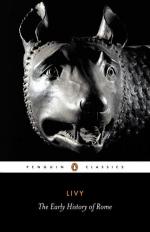
|
| Name: _________________________ | Period: ___________________ |
This test consists of 15 multiple choice questions and 5 short answer questions.
Multiple Choice Questions
1. Who does Tarquin recruit to assist him in the effort to regain Rome after he is banished?
(a) The Venetians.
(b) The Umbrians.
(c) The Etruscans.
(d) The Ligurians.
2. What are the women asked to disregard pertaining to the men they found themselves with at the start of Rome?
(a) Their attachment.
(b) Their resentment.
(c) Their fondness.
(d) Their hatred.
3. How are the Sabine people described in the book?
(a) They are a recurrent opponent of Rome.
(b) They are recurrent allies of Rome.
(c) They ignore Rome until they are attacked.
(d) They are not aware of Rome at the time the book was written.
4. How many tribes does Rome have at this point in their history in the second part of The Republic?
(a) Twenty one.
(b) Fifty one.
(c) Thirty one.
(d) Forty one.
5. According to one theory, how are Romulus and Remus related?
(a) They are half-brothers.
(b) They are fraternal twins.
(c) They are identical twins.
(d) They are cousins.
6. What does the group of pacifists call themselves?
(a) The peace coalition.
(b) The anti-war party.
(c) The peace party.
(d) The anti-war coalition.
7. What do the Volscians continue to be for Rome during the time of two consuls?
(a) A major ally of Rome.
(b) A source of food for Rome.
(c) A source of work for Rome.
(d) A major opponent of Rome.
8. What planet's name is given to the temple to a deity?
(a) Pluto.
(b) Saturn.
(c) Neptune.
(d) Jupiter.
9. What do the people do when creditors attempt to collect repayment in the courts?
(a) They file lawsuits against the creditors in retaliation.
(b) They protest the government by holding big rallies.
(c) They form mobs to protect the debtors.
(d) They encourage debtors not to attend the court proceedings.
10. What year does the book, Patricians at Bay begin?
(a) 576 BC.
(b) 467 BC.
(c) 476 BC.
(d) 567 BC.
11. How was the support of the people viewed by the Kings of early Rome?
(a) As valuable and easily attainable.
(b) As valuable, but not easily attainable.
(c) As a necessity.
(d) As unnecessary.
12. Although it is a decisive Roman victory, what are the total losses on both sides of the war that results in one of the consuls being injured, and the other being beheaded?
(a) Between fourteen and fifteen thousand men.
(b) Between nine and ten thousand men.
(c) Between eleven and twelve thousand men.
(d) Between eight and nine thousand men.
13. Which relative of Hostilius set the precedent for the meaning of the word "hostile?"
(a) His grandfather.
(b) His father.
(c) His uncle.
(d) His brother.
14. How is the problem of debt described?
(a) As an unmanageable civil and social problem.
(b) As a manageable civil and social problem.
(c) As a past social problem.
(d) As a past civil problem..
15. What is the population of Rome estimated to be during first part of The Patricians at Bay?
(a) 104, 714.
(b) 49, 714.
(c) 140, 714.
(d) 94, 714.
Short Answer Questions
1. What does the group, the Aurunci, consist of?
2. Which sign do Romulus and Remus become the symbol for?
3. How common is the interaction between human and divine beings in Ancient Rome, according to Livy?
4. What level of involvement do the leaders have in the war that featured debtors who agreed to fight in exchange for their debt being resolved?
5. What causes Servilius and Appius to become unpopular with the Romans?
|
This section contains 611 words (approx. 3 pages at 300 words per page) |

|




